Presentation:
Authors:
Rick Phillips
Ryan T. Cragun
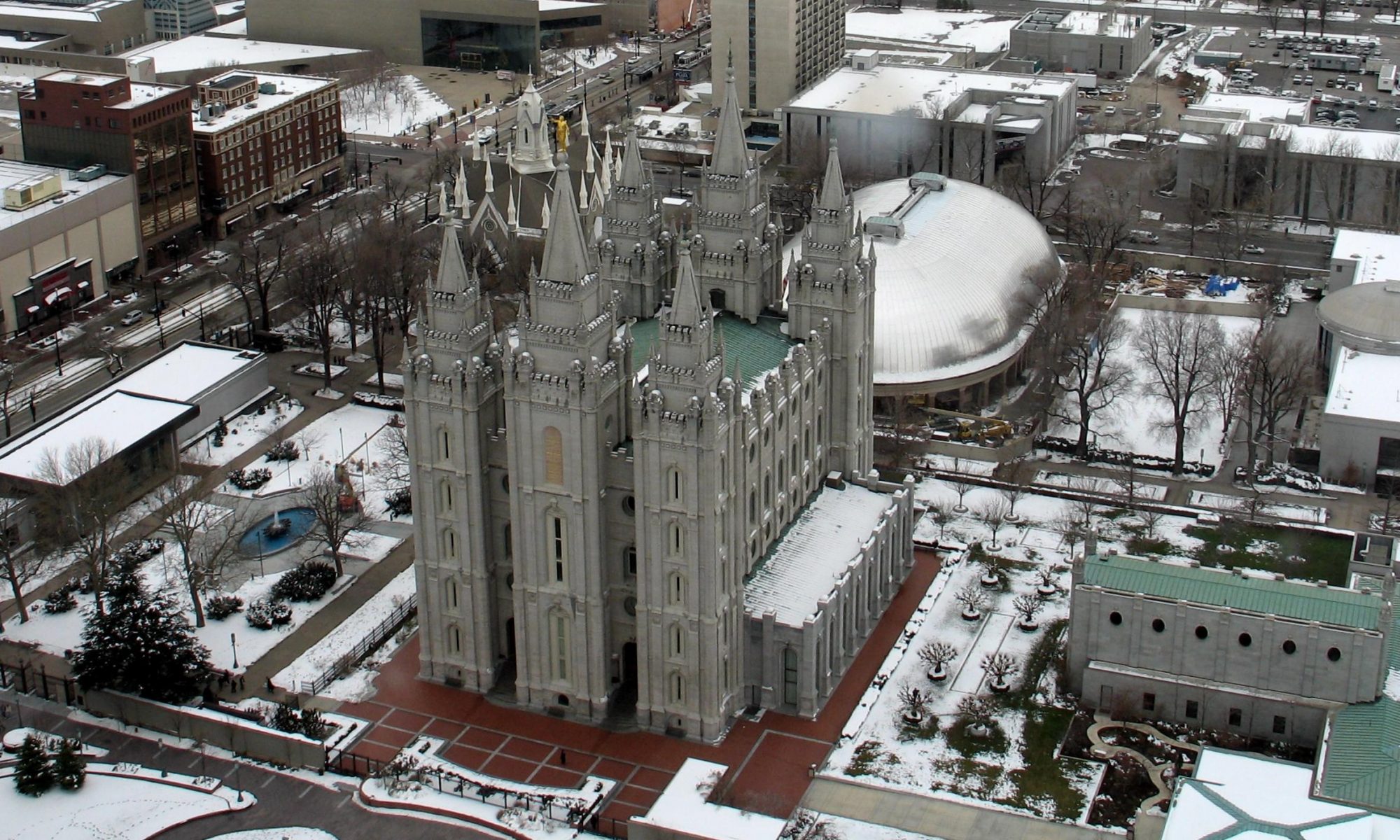
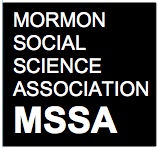
Mormon Social Science Association
bringing social science to Mormonism
Michael McBride arranged for a panel of MSSA members to answer questions on By Common Consent, one of the most widely read Mormon-oriented blogs. You can see the first part of this discussion here.
MORMON MEDIA STUDIES INTEREST GROUP LISTSERVE:
INFORMATION AND INVITATION TO JOIN
The Mormon Media Studies Interest Group was formed 26 February 2009 by a group of faculty members in the Department of Communications at Brigham Young University. The group’s e-mail distribution list was launched 9 March 2009. It moved to a listserve format on 28 April 2009.
The group recognizes the centrality of the media to the Mormon experience, historically and in the present, and acknowledges the unique contribution that can be made to Mormon studies by focusing on media from a wide range of academic perspectives.
Specific objectives of the group include (but are not limited to) the following:
The interest group is just in its beginning stages. As we find our way, we may expand beyond the listserve format to a blog or some other means of communication.
If you are interested in participating in this community of scholars, we welcome you. Also, if you know of others who might be interested, please invite them first to assess their interest. To be added to the list, newcomers should send an e-mail to Sherry Baker (sherry_baker@byu.edu) with an indication of name and e-mail contact information.
Q: I will begin a PhD program soon on the subject of Mormon myth and sacred narrative. I wonder if I could be pointed toward any research which might have been done previously on the place of myth as stories with culturally formative power that might be categorized broadly under headings like Restoration, Revelation, Missionary Stories, and stories of healing and encouragement. These would include stories on the Pre-Existence/Pre-Mortal Life, the First Vision, the Westward Trek/Pioneer Narrative, The Plan of Salvation/Personal missionary narratives, etc. Any thoughts on previous studies that have touched on myth, story, narrative, or folklore in these areas would be appreciated.
A: We have two responses to this question. The first comes from Steven Olsen:
“My Masters paper at the University of Chicago (Anthropology, 1978) adapted a Levi-Straussian ‘structuralist’ approach to understand the cultural logic of the sacred Mormon narrative we call “The Joseph Smith Story.” A readable version of that study appears in a Dialogue article from the 1980s with the pretentious title, “Joseph Smith and the Structure of Mormon Identity.” This study will be of value to the extent that John is concerned about theory and method in his own study; it illustrates a conception and approach to the study of sacred narrative that, I believe, bears some fruit. There are certainly other possible approaches, including those used by Bert Wilson, Eric Eliason, Meg Brady, and others in their study of Mormon narrative, oral and written. From the perspective of what Clifford Geertz might call, if he were still alive, “History as a Cultural System,” there are a couple of obscure articles that may be helpful, “The Theology of Memory: Mormon Historical Consciousness” in a recent FARMS Review and “Historic Sites as Institutional Memory,” in the proceedings of a BYU symposium several years ago, both of which were written by me. Additionally, at an ASCH conference a few years ago, Stephen Stein delivered what I remember as a masterful set of preliminary reflections on the implications of Mormonism’s being a literate religion, i.e., one that is grounded in the authority of written documents, some of which record historical experience. I have never seen it in print, but he would advance our understanding of Mormonism considerably if he would do so.”
Armand Mauss also wrote a response:
“If you are in Utah, you are located right in the center of the best collections of Mormon myth and folklore in the world at the three major universities in Utah. He should start by consulting the massive bibliography compiled a decade ago by James B. Allen, Ronald W. Walker, and David L. Whittaker (editors and compilers), STUDIES IN MORMON HISTORY, 1830 – 1997 (University of Illinois Press, 2000), which will be found in the reference section of any decent library, especially in Utah. In that bibliography will be found numerous sections devoted to myth and folklore, especially on pages 651-654, 799-800, and 1095-1096. The founder and earliest collector of Mormon myth and folklore was the late Austin Fife (often with his wife Alta), so John might begin by browsing through Fife’s work, which appears in a couple of books and numerous articles. Fife’s successor would be William A. (“Bert”) Wilson, still very much alive as English professor emeritus at BYU, and author of many great articles. An up-and-coming younger scholar specializing in Mormon myth and folklore is Eric Eliason, also in the BYU English Dept. Morehead would do well to seek out Wilson and Eliason for interviews. They would give him a lot of useful guidance, not only bibliographical but also methodological. But John should do considerable browsing through the work listed in the above-mentioned bibliography before seeking out Wilson or Eliason.”
Update: Mon, 2009-04-13 10:10 — Shawn Bennion
I would also suggest contacting Eric Eliason, who has an interest in Mormon Folklore. I recall his comment that the category of “3 Nephite” Stories is among the largest in all of the study of folklore. The L. Tom Perry Special Collections at BYU has a large collection of Mormon folklore, often containing transcripts of interviews.
Q: I wonder if you might have some thoughts on something. I’m beginning graduate school in religious studies and am looking at ways to raise funds for my research degree on Mormonism, Mormon sacred narratives, and their place in Mormon-evangelical dialogue. I am aware of the Fellowship Applications for visiting faculty through the Tanner Humanities Center, but do you have any suggestions as to possible funding, scholarship, or fellowship sources for a scholar looking to earn a PhD through research and a dissertation that adds something unique to Mormon studies and interreligious?
A: Here is Armand Mauss’s response:
“This is a tough one. The Tanner Humanities Center would be a likely source, perhaps next year if this year’s application deadline has passed. I don’t know how Tanner or other potential funding sources would feel about awarding fellowships for “long distance” degree programs, as contrasted with the normal residential expectations. For the Mormon-Evangelical relationship specifically, you should talk to Robert Millet (Religion, BYU), who is the most prominent Mormon scholar with an interest in that relationship. Millet (like Davies) is also a friend of Richard Mouw at the Fuller Seminary in Pasadena, and Mouw himself might well have some ideas about funding sources, given his interest in the Mormon-Evangelical dialogue.”
I do know that the rules against alcohol are a bit stricter in the AUB/Allred group. I know of a few patriarchs who have a glass of wine after dinner, but these are not in good favor with the Brethren who often restrict its use publicly. Yet, on one occasion a beer or two might be tolerated to ease the tensions before sex or after work. I gathered this material during a priesthood meeting in Pinesdale. It is obvious that fundamentalists do not recognize as strict an interpretation as orthodox Mormons do.
Thus, the FLDS and other polygamist groups do have slightly more relaxed norms toward alcohol use. Carrie Miles offers a suggestion for why this might be the case and offers some additional information:
Carrie’s suggestion that the fundamentalist Mormons look more like primitive Mormonism than does the LDS Church does reflect the much looser observation of the Word of Wisdom among Mormons prior to the 1900s. Joseph Smith was known to have consumed alcohol on occasion and Brigham Young ran a prominent bar in SLC, though not because he was a regular imbiber but to control the flow of alcohol. Thomas Alexander offers another explanation for the changing adherence of the Word of Wisdom among earlier Mormons:
Rick Phillips offers some additional information on this topic:
The Tanner Humanities Center is pleased to announce it has been awarded a grant from the George S. and Dolores Doré Eccles Foundation for $36,000 to establish the Eccles Fellowship in Mormon Studies. The award has been designated to support two doctoral students in researching and writing their dissertations ($18,000 stipend for each), one in 2009 and one in 2010. This fellowship targets Ph.D. candidates across the United States and the world who are researching the Church of Jesus Christ of Latter-day Saints, its members, and Mormon culture in the fields of History, Anthropology, Sociology, Education, Economics, Business, Political Science, Religion, or Literature. Through publications, work in the classroom, and in public forums, these future academics, writers, and teachers will have an impact on the study of Mormonism and on students and the general population.
This fellowship is the first in the United States and the world to focus specifically on Mormon Studies. In offering this opportunity at the University of Utah, the Center recognizes the important and unrivaled archival resources for research located in Salt Lake City and Utah. It also begins to redress the imbalance of opportunities facing those who choose to study Mormonism as opposed to Judaism, Catholicism, or Islam. This fellowship will also enhance the recent trend that seeks to raise Mormon Studies to a new standard of academic excellence.
For application forms and requirements please visit http://www.thc.utah.edu
For more information, see the Salt Lake Tribune’s article on the fellowship.
Q: I am researching the recent changes in missionary work and am trying to find out how to get a hold of retention rates for the church as a whole. Do you have any idea how I might find this type of information? I am also trying to figure out how to get numbers of potential missionaries, that is, the number of young men ages 19 that are the right age to serve missions so that I might be able to compare percentages before and after raising the bar on missionary standards. Finally, I want to make sure I have not missed any recent works about this topic including dissertations, articles, etc.
A: This is an interesting question. Unfortunately, it is also one that is a bit difficult to answer, primarily because the LDS Church does not release the data it collects on its members. As a result, the best we can do as researchers is find alternative ways to estimate this information. You may find the following estimates useful.
First, regarding retention rates… As noted above, the LDS Church does not release this information. But there are ways to estimate this and several researchers have done so, giving us our current best estimates. For instance, Rick Phillips (2006), using census data for a variety of countries, compared the membership information supplied by the LDS Church in its annual almanac to the self-reported membership identifications of people in those countries and found that the LDS Church over-estimated its membership. The actual number of Mormons in those countries ranged from 20% to 70% of what the LDS Church claimed. The major implication of this finding is that retention rates of Mormon converts are fairly low.
Rick, in response to your question, gave this example: If data from the Canadian census is representative, then the disparity between official membership totals and the number of self-identified Latter-day Saints is increasing. LDS demographer (and MSSA member) Tim Heaton observes: “In the 1981 Canadian census … 82,000 people stated Mormon as their religious preference, yet LDS records reported 85,006 members. The difference implies that 3-4 percent of members on the records [at the time did not] consider themselves Latter-day Saints.” By the next decennial census this disparity had widened. In 1991, about 94,000 Canadians identified themselves as Mormons, but the church claimed 130,000. Thus, in the space of 10 years the LDS church went from over-reporting its Canadian membership by 3-4 percent to over 28 percent. The latest data show that this trend continues. The 2001 Canadian census lists 101,805 self-identified Mormons, compared to the church’s claim of over 160,000. This means that over a third of the Canadians now listed on LDS church rolls do not profess to be Mormons. Outside traditional Mormon strongholds in Alberta, disparities are even wider. A similar pattern is observed for New Zealand, and other MSSA members can probably report on other nations as well.
Rick also notes that, with respect to the United States, two censuses of religious bodies, conducted in 1990 and 2000 by the Glenmary Research Center, found that Mormon membership in the U.S. increased 19 percent between the two enumerations. The Glenmary data relies on information furnished by participating denominations, and hence this conclusion is based on figures provided by the LDS church. By contrast, two large-scale surveys of self-reported religious identification, the National Survey of Religious Identification (NSRI) and the American Religious Identification Survey (ARIS), conducted in 1990 and 2001 respectively, tell a different story. The 1990 NSRI estimates the adult LDS population at 2.5 million, while the 2001 ARIS estimates it at 2.7 million—an 8 percent increase. Differences between the Glenmary data and these self-report surveys imply that many of those who were baptized Mormon in this decade defected, but are still counted as members by the church. Kosmin, Mayer and Keysar write: “[Mormonism] appear[s] to attract a large number of converts (‘in-switchers’), but also nearly as large a number of apostates (‘out-switchers’)” This same finding is echoed in a new report by the Pew Forum on Religion and Public Life.
Rick Phillips has also pointed out that that retention rates are strongly negatively correlated with growth rates, and that those nations that have high growth rates have low rates of convert retention. Rick discusses Mormon convert retention in two articles, one currently published (2006) and one coming out in the next issue of JSSR (see references below). The bibliographies of these papers cite most of the research on this subject. If your library does not carry these journals, we can provide offprints.
Rick also suggested some other sources, depending on your definition of “retention.” If you want to define “retention” as some level of church participation, then Tim Heaton’s “Vital Statistics” entry in the Encyclopedia of Mormonism is the best place to start. You may also find this discussion of retention by Elder Oaks instructive.
There are some other sources of information on retention in the LDS Church. For instance, Henri Gooren (2008) found in his field research in Central America that half of all new members left the religion within a year; more leave after that. That would indicate retention rates lower than 50%. David Stewart, in his book on Missiology and Retention, claims various retention rates, but most center around 20% to 30% (see pages 257-280). Stewart cites several mission presidents in his book who admit retention rates ranging from 8% to 18% (p. 278). Unfortunately, many of the retention rate estimates in Stewart’s book are not referenced and it is unclear how he arrives at his numbers.
In sum, best estimates of retention rates for converts to Mormonism would probably put the number somewhere between 20% and 50%, depending on the country.
As regards your second question of potential missionaries… There are really two components here. The first is the actual number of potential missionaries and the second would be their potential impact on growth of the religion. Rick Phillips, in his response to your question, noted that the only sure way of finding out the number of 19 year olds would be to contact the Research Division of the LDS Church. Whether they would release that information is not clear, but you could try. However, there is a way to arrive at an estimate for the US. The US Census Bureau generates population estimates by age and sex for each state every year. The latest year of data available is 2007 (http://www.census.gov/popest/datasets.html). Using that data, you can create population pyramids (a demographic technique) that illustrates the age/sex structure of a population. Ryan Cragun used that data to generate four population pyramids (see Figures 1 through 4 attached below). While it is true that Utah is decreasingly a good proxy for Mormons in the US, generally, careful scrutiny of the population pyramids does give an indication of the number of young men moving into mission ages. What you see in Figure 4 (the Utah population pyramid from 2007) is a large difference in males in the 21-25 age range compared to the 16-20 range. That large difference would suggest that the number of Mormon missionaries is going to drop substantially in the coming years (and probably helps explain the large recent drop in missionaries). Considering the 11-15 and 6-10 year age ranges are closer to the 16-20 age range in size, the smaller number of missionaries (from Utah at least) is likely to continue for the next 15 years or so. However, there is a possibility that the lower numbers in Utah (and the US, generally) may be slightly offset by growing numbers of missionaries outside the US as population pyramids outside the US in developing countries are much wider at the bottom (in younger age ranges) than at the top. But all of this also depends on the percentages of 19 year olds who serve missions, a number that is also unknown except by the LDS Church. Additionally, the reduction of missionaries may be due to the “raising the bar” efforts of the LDS Church in the early part of this decade, but the demographic shift seen in Figure 4 seems to suggest otherwise.
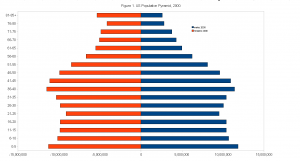
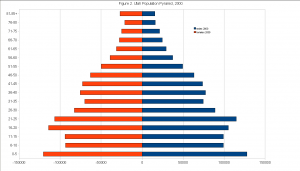
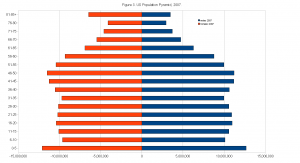
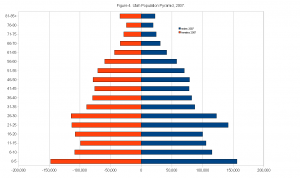
If you couple the declining 19 year old population with the lower returns from missionary efforts, the future of Mormon growth looks even more interesting. Rick Phillips noted in his response to this question that the number of convert baptisms per missionary has fallen over the last 20 years. In 1986, there were 6.3 baptisms per missionary, in 1997 this fell to 5.6 converts per missionary, and the latest almanac shows 5.1 baptisms per missionary for 2007 (David Stewart estimates it as 4.5 converts/missionary from 2000 to 2004; see p. 23). Thus, the smaller number of eligible young men to serve missions combined with the lower returns of their efforts (and other factors) indicate Mormon growth is probably going to continue to slow.
One last item you may find interesting is the attached Balance Sheet of Mormon growth in the US by MSSA member Richley Crapo (attached below). It shows that LDS growth in the US is much lower than the actual conversion rate.
Hopefully this answers your questions. If you have any other questions, please let us know.
References:
Gooren, Henri. 2008. “The Mormons of the World: The Meaning of LDS Membership in Central America.” Pp. 362-388 in Revisiting Thomas F. O’Dea’s The Mormons: Contemporary Perspectives, edited by Cardell K. Jacobson, John P. Hoffman, and Tim B. Heaton. University of Utah Press.
Phillips, Rick. (2006) “Rethinking the International Expansion of Mormonism.” Nova Religio: The Journal of New and Emergent Religions 10(1):52-68.
Phillips, Rick. (In press) “‘De facto Congregationalism’ and Mormon Missionary Outreach: An Ethnographic Case Study.” Journal for the Scientific Study of Religion 47(4):628-643.
Stewart, David G. 2007. The Law of the Harvest: Practical Principles of Effective Missionary Work. Henderson, NV: Cumorah Foundation.
Update 1: Fri, 2008-11-21 23:52 — Shawn Bennion
I would like to point out on Richley Crapo’s chart that the net gain in Mormon membership (E4) does not include children of record in the United States for 2007. Though I do not have a specific number, this would add to the net total, meaning that the church growth for the year would be higher than the U.S. general birth rate. While I understand that his intent was to show movement through agency, I feel that this is still an important factor in terms of growth trends of Mormonism.
Update 2: Sun, 2009-08-16 08:07 — David Stewart
Terminology needs to be clearly defined, as activity is officially defined as the number of members who have attended church at least once in the past three months, whereas activity rates are regarded colloquially (and by many sociologists) as the percentage of members attending church on a given week. The latter number is more meaningful, and more measurable, although it is not technically an “activity rate” according to the Church’s definition.
It is stated above that “David Stewart, in his book on Missiology and Retention, claims various retention rates, but most center around 20% to 30% (see pages 257-280)…Unfortunately, many of the retention rate estimates in Stewart’s book are not referenced and it is unclear how he arrives at his numbers.” This is because the wrong section in my book is cited above. Pages 257-280 principally comprise the chapter “Understanding the Conversion Process” which deals with theoretical issues and matters of practical implementation.
The references on LDS activity and convert retention rates are found primarily in the chapter “Trends in LDS Member Activity and Convert Retention,” pp. 36-50, online here. Every statistic there is referenced, and so there should be no confusion regarding how any number has been arrived at.
Additional data can be found in my “LDS Church Growth, Member Activity, and Convert Retention: Review and Analysis” which is online here. This review includes itemized data from relevant sources (national censuses, independent sociologic studies, statements of church leaders, and quasi-official sources like the Encyclopedia of Mormonism) divided by geographic region, with the pertinent supporting references, and a discussion of key considerations which are essential to the proper analysis and understanding of LDS growth and retention data (double affiliation, address unknown file, survey methodology, unknown denominator, outcome reporting bias, and so forth).
That individuals identify themselves as Latter-day Saints on national censuses in Chile, Brazil, Mexico, the Philippines, etc., does not necessarily imply that they attend church, but one can be fairly confident that those who do not identify themselves as members do not attend. Such data thereby define “ceilings” on possible participation, even if the lower limit is difficult to precisely define. However, there are relatively few believing but non-participating members outside of the U.S. (see articles by Van Beek, Decoo, Numano, and others in the Spring 1996 Dialogue). By aggregating membership participation, affiliation, and self-identification data by country or region, it is clear that the number of Latter-day Saints attending church worldwide on any given Sunday cannot exceed 35% of nominal membership. My best estimate is that the true figure is likely in the 28-33% range; the limitations of currently available data do not permit greater precision than this.